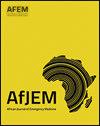埃塞俄比亚亚的斯亚贝巴提供基于设施的紧急护理的障碍和促进因素:一项混合方法研究
IF 1.2
4区 医学
Q3 EMERGENCY MEDICINE
引用次数: 0
摘要
背景:在低收入和中等收入国家,急诊可能造成的疾病和伤害占所有死亡人数的一半以上。然而,研究表明,这些国家的急诊科在以设施为基础的紧急护理方面面临许多障碍。然而,关于埃塞俄比亚基于设施的紧急护理的障碍和这些障碍的一些原因的数据尚未建立,本研究旨在弥合这一差距。方法采用解释性、顺序混合方法设计。在第一阶段,使用世卫组织的医院急诊单位评估工具(HEAT)对五家医院进行了横断面评估。采用目的抽样法选择医院,采用便利抽样法确定调查对象。定量数据进行描述性分析。在第二阶段,进行了深入的关键线人访谈。定性资料采用内容分析法进行分析。最后,对两阶段的结果进行积分。结果我们在第一阶段调查了38名参与者,在第二阶段采访了15名参与者。从研究的定量阶段得出的最明显的发现是,来自各医院的参与者报告说,缺乏设备(119例)和供应品缺货(47例)是两个最常见的障碍。同样,所有医疗机构不提供诊断服务的最常见原因是缺少设备(n = 128)和缺货(n = 99)。从研究的定性阶段确定的最重要障碍包括资源短缺或缺乏,以及资源管理不足。为他们可以执行的程序确定的促进因素是基本资源的可用性,包括训练有素的人力资源、良好的管理做法和工作人员之间的协调。结论:总体而言,亚的斯亚贝巴的三级医院报告说,尽管有些服务中断,但它们可以在急诊科执行大部分诊断和治疗程序。一些服务的完全缺失或中断是由于一些障碍造成的。现有文献和本研究的结果都表明,埃塞俄比亚医院的EUs需要进一步投资,以提高资源的可用性和对可用资源的适当管理。本文章由计算机程序翻译,如有差异,请以英文原文为准。
Barriers and facilitators to providing facility-based emergency care in Addis Ababa, Ethiopia: A mixed methods study
Background
Illness and injury that may be impacted by emergency care account for over half of all deaths in low- and middle-income countries. However, studies show that Emergency Units in these countries face numerous barriers to facility-based emergency care. Yet, data on the barriers to facility-based emergency care in Ethiopia and some reasons for these barriers have not been established, and this study aimed to bridge this gap.
Methods
The study followed an explanatory, sequential mixed-methods design. In phase one, a cross-sectional evaluation of five hospitals was done using WHO's Hospital Emergency Unit Assessment Tool (HEAT). A purposive sampling technique was used to select the hospitals, and a convenience sampling technique was used to determine the participants. Quantitative data were analysed descriptively. In phase two, in-depth key informant interviews were done. Qualitative data were analysed using content analysis. Finally, the integration of the results from the two phases was done.
Results
We surveyed 38 participants in phase one and interviewed 15 in phase two. The most apparent findings to emerge from the quantitative phase of the study were the participants from across the hospitals reported the absence of equipment (n = 119) and stock out of supplies (n = 47) as the two most common barriers. Similarly, the most common reasons reported for not performing diagnostic services across all facilities were absent equipment (n = 128) and stock out of supplies (n = 99). The most important barriers identified from the qualitative phase of the study included a shortage or lack of resources, and inadequate management of resources. The facilitators identified for the procedures they could perform were the availability of essential resources, including trained human resources, good management practices, and coordination among the staff.
Conclusion
Overall, the tertiary hospitals in Addis Ababa reported they could perform the majority of the diagnostic and therapeutic procedures in the emergency units despite the interruption of some of the services. Some of the services' complete absence or interruptions were due to several barriers. Both existing literature and the findings of this study indicate the EUs of Ethiopian hospitals need further investment to improve resource availability and proper management of available resources.
求助全文
通过发布文献求助,成功后即可免费获取论文全文。
去求助
来源期刊

African Journal of Emergency Medicine
EMERGENCY MEDICINE-
CiteScore
2.40
自引率
7.70%
发文量
78
审稿时长
85 days
 求助内容:
求助内容: 应助结果提醒方式:
应助结果提醒方式:


